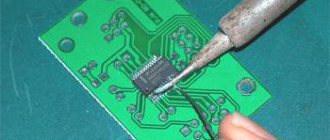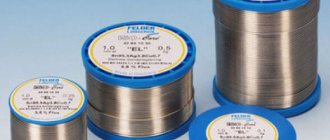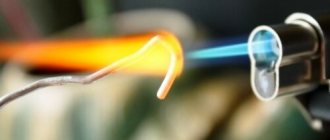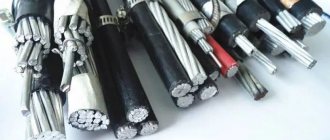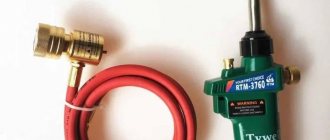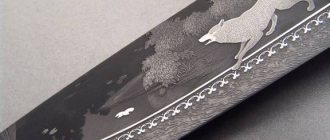When it is necessary to reliably fasten various solid connections together, soldering is most often chosen for this. This process is widespread in many industries. Home craftsmen also have to solder.
This operation helps not only when the TV or computer has failed, and to restore it it is necessary to replace the burnt microcircuit or chip. Using this process, refrigeration equipment and industrial systems are restored. Soldering helps if you need to get a tight connection. In addition, some materials simply cannot be combined in any other way.
Aluminum, copper, and brass cannot be joined by welding. In order to obtain a high-quality and reliable, as well as hermetically sealed connection, you need to have not only good equipment and special skills, but also suitable consumables - solders and fluxes for soldering.
Solder alloys and types of flux are selected depending on the materials with which you will have to work. For example, when working with aluminum products, a different flux is needed than what is suitable for copper or silver. Below we will look at the main characteristics of each of them and choose the best option for the job.
Wettability
First of all, any type of solder must have excellent wettability. Without this characteristic, the parts being soldered simply will not be able to reliably contact each other. What is wettability? This is such an interesting phenomenon when the strength of the bonds between the particles of a solid and a liquid is higher than that of the molecules of the liquid. If there is wettability, then the liquid will spread over the surface and enter all cavities. So, if solder solder does not wet copper, for example, then it cannot be used on that metal. Pure lead is not used for soldering. Its wetting characteristics are very poor and high quality joints cannot be counted on.
Soldering copper pipes
Solders designed for soldering copper pipes work well with pure copper, as well as with other additional alloys. Using flux, you can quickly and easily remove oxidation, so the process is greatly simplified. Other metals form oxides that fluxes are practically unable to dissolve, so it is worth taking care to solve this problem. When soldering copper pipes, it is necessary to use the overlapping option so that the structure is as strong as possible and has a long service life. To make the connection high-quality and durable, it is necessary to make an overlap of at least 5 mm. The seams here are made of any thickness, and the quality of the joints does not depend on this. During soldering, small gaps are left so that the solder is drawn evenly into the hole and becomes airtight.
Types of solders for copper pipes
- 1S is a soft type solder. It contains silver. It is perfect not only for copper pipes, but also for bronze and brass workpieces, which are often used for water supply. This solder does not contain flux, so it must be purchased additionally.
- Rosol 3 solder is a soft type of material; when using it, you must purchase flux. It melts at a temperature of 240 degrees Celsius. That is why it is excellent for soldering thin products. After soldering, it holds up remarkably well at low and high temperatures.
- Rolot 94 solder is hard solder. This material of the highest quality is used to work with copper products, red bronze and brass. It is usually used for soldering pipes using the capillary method. Its melting temperature reaches 730 degrees Celsius, so it is not recommended to use it for working with products with thin walls.
- Rolot 2 solder is a non-standardized hard-type solder. It contains some silver content, so the material is excellent for soldering standard type products.
Read also: How to draw a hexagon in a compass
It is necessary to separately note the solders for soldering food-grade copper. They must be completely harmless to human health. Such solders also have several types:
- Tin-copper solder includes zinc and silver. This solder is used for soldering copper pipes at high temperatures, which is capable of providing a ductile and high-quality connection that is resistant to corrosion and has a long service life;
- Silver-copper solder is a low-temperature material, melts very quickly and forms a strong connection that is resistant to corrosion;
- Copper-phosphorus solder is a high-temperature material; when using it, there is no need to purchase additional flux. The seam is elastic and of high quality;
- Copper-silver solder is a high temperature solder. The seams are very durable and flexible. When using it, it is necessary to purchase additional flux. Its cost is quite high, so it is not suitable for everyone.
Melting temperature
Whatever the type of solder, the temperature at which it begins to melt must necessarily be below the melting point of the materials being soldered. It should also be higher than the operating temperatures of the parts.
When we talk about melting point, we mean two points. This is the value at which low-melting components will begin the melting process, and the minimum at which the alloy will turn into a liquid. The difference between these two temperatures is called the crystallization interval. If the soldering site is within this difference, then even small mechanical loads on the part can completely destroy the structure of the solder. Such a connection will exhibit high fragility and resistance. Remember the main thing: you should not influence the connection in any way until the solder solder has completely crystallized.
Honda Civic Hatchback 'Pneumatic Square' › Logbook › Clear brushes. Mini-FAQ on the starter.
Greetings, friends! Today's show, like most of my posts, has a technical slant. I try, you know, to be useful to those people who cannot afford expensive repairs or spare parts. Well, for me it's a hobby

